A few days ago, Microsoft Research Labs released a major beta update to their free WorldWide Telescope (Windows only). Among its many improvements, the “Autumnal Equinox” release includes a new way of exploring the universe — instead of just zooming in on photographs of the night sky as seen from Earth (as you do with Google Sky), you can now also travel through a 3D model of the Solar System, the stars in our galaxy and out past the furthest observable galaxies and quasars, giving you a fantastic view of the superstructure of the universe.
This is the first time that a 3D visualization of the furthest observable objects in the universe has been made so accessible to the casual user, for free. Similar data has been freely available for a while (for Windows, Mac, and Linux) if you know where to look. In this post I’m going to look at the state of these virtual universes, now that Microsoft has entered this application space.
Microsoft’s 3D view of the universe most clearly lends comparison to the current open-source favorite, Celestia (for Windows, Mac and Linux). It too simulates the Solar System and nearby stars, and with a bit of effort you can upload a database of around 250,000 galaxies far far away, taken from the Sloan Digital Sky Survey (SDSS). Microsoft says its galaxy database contains half a million objects, but doesn’t name the source. A third free virtual universe worth looking at is Digital Universe, by NYC’s Hayden Planetarium, a massive downloadable dataset that comes with PartiView (for Windows, Mac and Linux), its own (highly quirky) viewer.
I most want to compare the view for these three free apps from >1 gigaparsecs out, as this is where it gets to be the most mindblowing, but first let’s look at how WWT and Celestia compare on their respective renditions of the Solar System.
WWT beta’s Solar System doesn’t yet eclipse Celestia’s, which is still a much more polished piece of work for this kind of exploration. For example, check out the shadows on Saturn; Celestia doesn’t just render the shadow of Saturn on the rings, but of the rings on Saturn, unlike WWT.
Celestia:

Microsoft WorldWide Telescope:
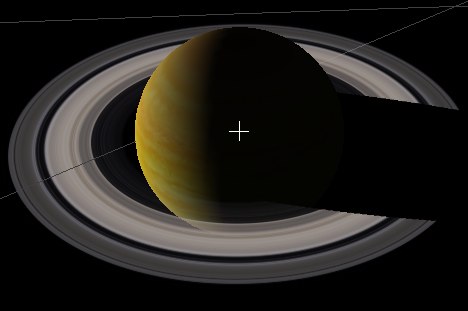
As for moons, WWT only shows our Moon and Jupiter’s four biggest ones. Celestia visualizes (with orbits and, where available, surface textures) all the Solar System’s known moon, and plenty of asteroids as well. (Minor hitch for Celestia: Saturn’s ring-hugging moons stay bathed in sunlight even as they dip into Saturn’s shadow, though I’m in not really in a position to nitpick:-)
Celestia is currently also more versatile when it comes to looking at the data — you can fly around in Celestia’s universe, as if in a virtual spaceship, at up to millions of light years per second. In WWT you are limited to choosing an object and then zooming and rotating it. Zoom all the way out from any Solar System object in WWT, and you get to see the furthest galaxies, but only ever with the Milky Way at the center of your field of view. (Celestia has other advantages too — your point of view is fully scriptable — but that’s beyond the the remit of this article.)
With WWT, however, it is easier than with Celestia to get to see the universe at scales where its superstructure is revealed. There are a few steps involved, however: First, select WWT’s new 3D viewing mode, called Solar System:
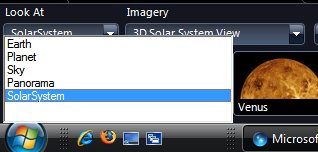
Then, download the galaxy database in WWT by checking “Cosmos” in the View menu.
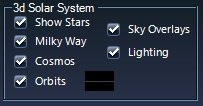
You’ll then get this ominous-sounding warning:
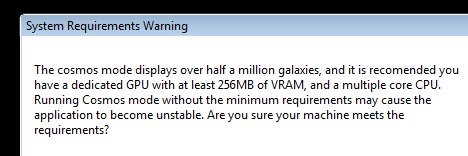
Luckily, it seemed to work fine on a friend’s year-old HP laptop. Once you have the data, start zooming out. When you get to a distance of 1 gigaparsec or more, you start seeing the filaments of galaxies that ring the voids of deep space. Here’s a quick 20 second demo of the view of Earth from 2 gigaparsecs out:
Half a million galaxies from Stefan Geens on Vimeo.
The video doesn’t do the full screen view justice. As you can see, the available data covers several slivers of the sky as seen from Earth.
If you want a similar view in Celestia, here’s what you need to do:
Once Celestia is installed, you need to find and download an extra data package at the Celestia Motherlode. The one we want is on the Extrasolar data plots page, the second version of the SDSS DR2 Galaxies dataset (ZIP file). Unzip this, and put the entire resulting folder into the Extras folder of Celestia’s CelestiaResources folder, like so:
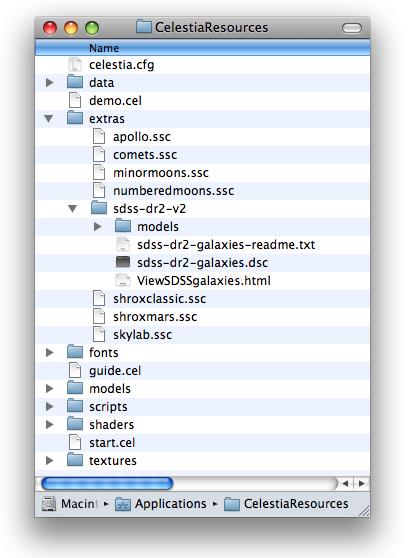
Restart Celestia. Then, not too intuitively, you need to go to Celestia’s Preference/Control panel, and make sure that the checkbox to show “Nebulae” is set, since that is what the dataset characterizes itself as to Celestia. Now Celestia too shows you the furthest observed galaxies, with the added bonus that you can make loop-de-loops through superclusters of galaxies at crazy speeds in your hypothetical spaceship.
A third approach is more data-centric. Hayden Planetarium makes its Digital Universe dataset available as a free download, together with a viewer, PartiView. (This dataset is also incorporated in a number of professional planetarium applications, such as Sweden’s SCISS AB’s UniView software. I took a video of a demo of UniView at ISDE5 in 2007).
PartiView is a strange beast. It is available for Windows, Mac, Linux and IRIX, but its rudimentary interface and affinity for command-line consoles don’t win it any beauty or usability contests. PartiView doesn’t do fancyful stuff like surface textures of planets — its one strength is the brute force rendering of constellations of particles, which is ideally suited to these kinds of extragalactic datasets. When it comes to this kind of data (of which the Sloan Digital Sky Survey is just one of several datasets available) PartiView can really put on a show:
Hayden Planetarium’s PartiView: Lots of galaxies from Stefan Geens on Vimeo.
You will need to RTFM to use PartiView, however.
To conclude: For navigating the Solar System and nearby stars, Celestia still rules, though bear in mind that WWT is beta. WWT provides the easiest path to getting a sense of the size and the composition of the visible universe (if you have Windows), while for those willing to do the work, PartiView offers the most data and can produce some beautiful results.
(For those willing to pay, Starry Night also offers a 3D simulation of the Solar System and nearby stars. I haven’t tried it.)
You forgot to mention that WWT seems to render Saturn as a sphere (based on the screenshot) whereas Celestia renders it in its correct oblate spheroid shape. Saturn is the most flattened spheroid planet and the screenshot shows how obvious WWT’s limitation is.
Two comments from Europe (and not from Hayden Planetarium):
1) Partiview can be used quite easily
2) The sentence “This is the first time that a 3D visualization of the furthest observable objects in the universe has been made so accessible to the casual user, for free.”
is wrong. That is many years I am using partiview and it contained SDSS and 2DF data.